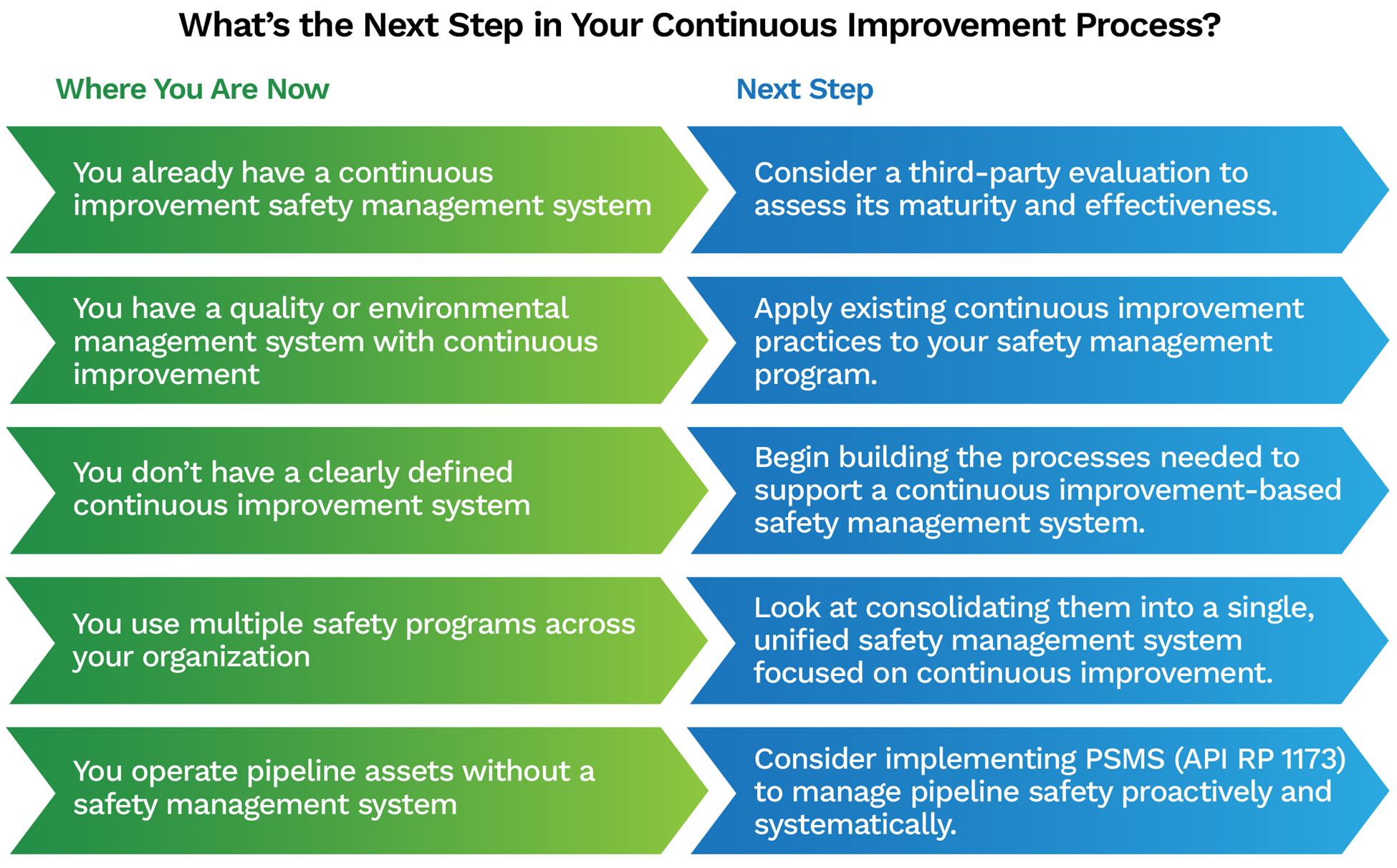
Enhancing Process Safety: Why Pipeline Leaders Are Turning to PSMS
July 14, 2025
By: Rick Lide
In high-risk industries—such as chemical manufacturing, oil refining, and industrial gas processing—companies are required to implement structured safety management systems designed to prevent major accidents and operational hazards. While some adopt programs to meet these requirements, others go further by choosing to implement systems that help them better manage risk, improve performance, and build a stronger safety culture.
Pipeline operators are a prime example. Although pipelines in the U.S. aren’t subject to mandatory safety management rules; such as OSHA’s Process Safety Management (PSM) or EPA’s Risk Management Program (RMP), many companies are voluntarily adopting the Pipeline Safety Management System (PSMS), also known as API Recommended Practice 1173. Developed with input from industry and regulators, PSMS offers a flexible, structured approach to improving operations and reducing risk in the pipeline industry.
The need for such systems is clear: These numbers underscore the critical importance of proactive safety practices across the sector.
In some cases, high risk operations, like chemical plants or refineries, that are required to have safety programs under PSM or RMP, also operate short length pipelines. These companies often expand their regulatory safety systems to cover their pipeline assets. Integrating PSMS elements into an existing regulatory safety management program helps move beyond compliance toward continuous improvement.
Any facility can benefit from this approach—especially those looking to make safety more proactive, people-centered, and performance-driven.
Strengthening PSM and RMP with PSMS Principles
OSHA’s PSM standard and EPA’s RMP provide a strong regulatory foundation—but they’re often focused on compliance tasks rather than long-term performance. By incorporating elements of the Pipeline Safety Management System, companies can shift from a reactive, compliance-based approach to one centered on continuous improvement.
Here’s how integrating PSMS into an existing PSM or RMP program can enhance safety performance.
More Meaningful Employee Engagement
Traditional PSM/RMP programs often limit employee participation to periodic hazard analyses or procedural reviews. PSMS expands that role—encouraging employees to actively contribute to safety culture assessments, flag risks, and to offer improvement ideas on an ongoing basis.
Incorporating these practices into a PSM/RMP framework fosters shared responsibility across all levels of the organization. Leadership plays a key role in setting and managing clear safety goals. Designated champions or subject matter experts help raise awareness and improve performance in specific safety areas with the intent to improve communication and engagement across the organization. PSMS also encourages involving external stakeholders—such as community members or emergency responders—whose concerns can help uncover overlooked risks and guide improvements.
The result is a more collaborative and transparent safety culture where continuous improvement becomes part of everyday operations.
Goal-Setting That Drives Improvement
Continuous improvement exists in all safety programs, but under PSM or RMP, it’s often reactive, triggered by incidents or changes. PSMS takes a more proactive approach by requiring clear goals and objectives for each safety management element.
This structure engages the whole organization: leadership sets realistic and measurable goals, middle management defines how frontline teams will meet them, and employees carry out the work to support them.
Goals can start with basic compliance and grow over time to focus on efficiency, communication, or engagement. The result is a safety system that evolves, improves, and becomes deeply embedded in daily operations.
Management Review That Drives Accountability
A key part of continuous improvement is taking time to reflect—and that’s exactly what PSMS builds into its structure through formal management reviews. This process gives leadership the opportunity to evaluate what’s working, what’s not, and what needs to be improved.
Reviews draw on data from across the safety system, including performance metrics, goal progress, employee feedback, and benchmarking. This allows leaders to understand why certain goals were met—or missed—and what resources (people, time, budget) are needed going forward.
Unlike reactive approaches, regular management reviews enable proactive decision-making. They help set priorities, align resources, and ensure the safety program continues to evolve with the organization’s needs.

Whether your operations are working to enhance an existing safety program or just beginning to explore PSMS, the goal is the same: to create a safer, more resilient organization. By integrating PSMS principles into your PSM or RMP framework, you can shift from reactive compliance to proactive, ongoing improvement.
Your Partner in Proactive Process Safety Management
Montrose Environmental has the expertise to assist clients with initiating process safety management programs and upgrading safety management systems into continuous improvement safety management systems. Our expertise includes consolidating different safety management systems into a single unifying management system, the implementation, assessment and auditing of PSMS, and conducting third-party audits under OSHA PSM and EPA RMP.
Let’s work together to make safety a lasting strength across your organization. Contact us to improve your safety management program.
 Rick Lide
Rick Lide
Line Manager
Rick Lide was working in process safety management before the finalization of the OSHA PSM rule. Since then, Rick has implemented RMP programs for various industries from oil/gas exploration, refining, chemical manufacturing, and logistics. Rick is an experienced safety management auditor with experience in auditing safety management across North America, Europe, Australia, Africa and Asia under local regulation and corporate requirements. When API RP 1173 was finalized, Rick developed communication/educational materials and the first edition of implementation tools for the Pipeline Industry Group (PipelineSMS.org). Working with API’s Global Industry Services, Rick helped set up the PSMS Assessment Program and has led several assessments in that program.




